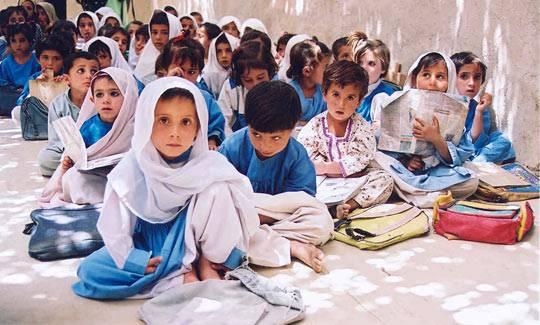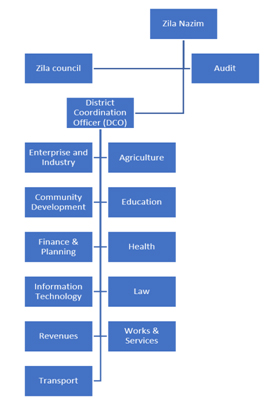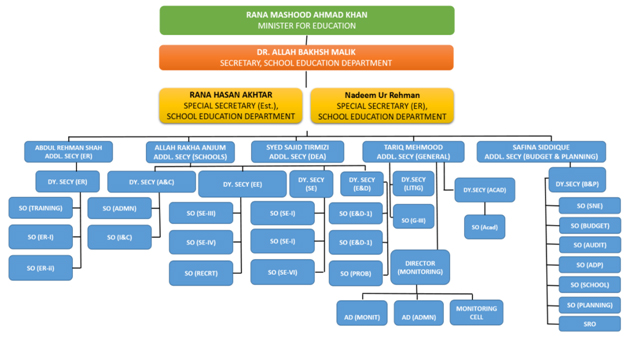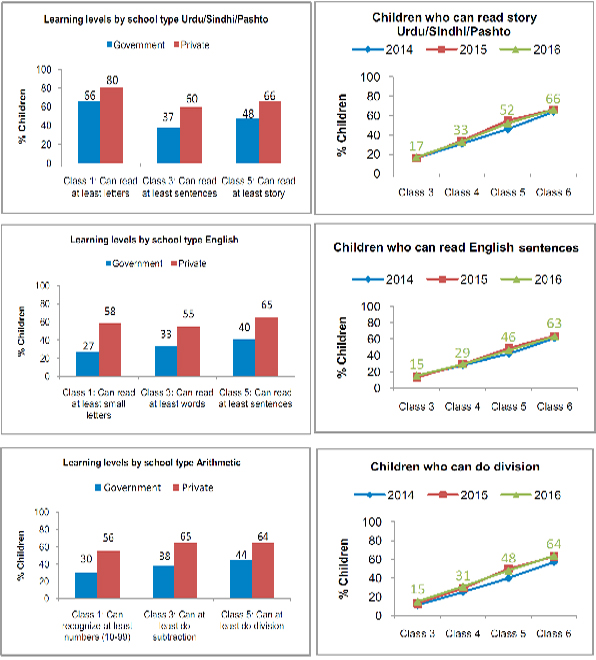
By Ali Abbas & Minahil Asim
Overview of decentralization in Pakistan
The key idea of decentralization is to provide power to those who are closest to local communities. Such representatives and civil servants have a better understanding of the needs of communities, and decentralization provides them with the power that they need to respond to such needs. In the same vein, over the last two decades, political, fiscal and administrative roles and responsibilities related to the education sector have been decentralized in Pakistan. This piece deconstructs the process of decentralization in Pakistan, especially in the context of the educational sector, and leans on some basic statistics to see how educational indicators have performed during this time.
First round of decentralization - things move from the province to the district level:
Prior to 2000, education was primarily a federal responsibility. However, this changed dramatically during the Musharraf era. The first major move towards decentralization shifted responsibilities from the provincial to the district level, by making the district, instead of the province, the operational tier of governance. This change was implemented through the provincial promulgation of the Local Government Ordinance (LGO) in 2001.

The LGO followed the broader Devolution Plan of 2000 introduced by President Pervez Musharraf. At the district level, the Nazim became the chief executive. The district administration and the police reported to him. In terms of the district’s administration, the District Coordination Officer (DCO) became all powerful, and was expected to coordinate 12 different departments, one of which was education. Each of these departments was headed by an Executive District Officer (EDO), who reported to the DCO.
The education department was one of these 12 departments. It was headed at the district level by the EDO-Education, who became the central player in local level education governance. The district education department had a provincial counterpart, which was headed by the minister of education who worked alongside the education secretary, usually a career bureaucrat. Following the promulgation of the LGO, planning, monitoring and evaluation of education, as well as disbursement of salaries, and the management of teaching and non-teaching staff was transferred to the district level. Thus, districts became the backbone of education governance in Pakistan. However, provincial governmentswere still responsible for the sanctioning or elimination of educational posts and positions such as those for teachers. This has been problematic, since district-level staff understands the needs of the community better, but cannot respond to the need for teachers on its own.
Further, the provincial governments also created specialized, technical units. Examples include the Reform Support Unit (RSU) within the Education and Literacy Department, Sindh province and the Program Monitoring and Implementation Unit (PMIU) within the School Education Department, Punjab province.
Second round of decentralization - federal to provincial level:
The next big step in the decentralization story was the enactment of the 18th Constitutional Amendment of 2010. Under this amendment, a further transfer of responsibilities was made, this time from the federal to provincial levels. The amendment removed shared responsibilities between the federal level and the provinces, including curriculum and syllabus, planning, policy centers of excellence, standard of education, and Islamic education, and made them the sole responsibility of the provinces. This substantially increased the strategic and policymaking responsibilities of the province.
Following the amendment, the federal ministry of education underwent a number of name changes, with federal authorities finally settling on the title, Ministry of Federal Education and Professional Training in 2014. The ministry is primarily responsible for providing technical, vocational and professional skills and training, and collaborates with other organizations to create sponsorships and scholarships for students. Departments reporting to the ministry include the National Vocational and Technical Training Commission, National Commission for Human Development, National Education Foundation and the National Education Assessment System.
In terms of fiscal decentralization, the 18th amendment required the federal government to provide provinces with funding for education via the National Finance Award (NFA) – a formula that divides the revenue pie between the four provinces. However, tax revenues generated by provinces meet the major chunk of funding required for education at the provincial level. Certain projects and reforms are funded by loans, grants or assistance provided by bilateral and multilateral agencies. At the local level, districts are funded by own-revenue, provincial non-earmarked block grants, and ad-hoc education grants transferred from the federal level. It is important to note that the DCO is the principal accounting officer, and all funds flow through his or her office.
An example of the provincial organizational structure taken from the current Punjab educational set up is provided below:

Under larger decentralization reforms promulgated by the World Bank for its aid recipient countries in 1990, Pakistan also underwent the establishment of School Management Committees (now known as School Councils (SC)). The key aim was to devolve authority to the school level and encourage participation of local communities in school management and governance i.e., those familiar with the needs of the communities could influence school level outcomes more effectively. It was not until 2007 that formal SC policies were created, which listed a number of tasks for SC members and broadly defined their constitution.
The members of this community-level council include the Head Teacher, parents, and notable members of the communities such as the numberdar or a shopkeeper. Their tasks include improving enrollment within schools, monitoring teacher and student attendance, hiring temporary teachers, and ensuring functionality of school facilities. For example, in Punjab province, beginning in 2015, SCs have been given a non-salary budget amounting to Rs 40,000 for secondary and Rs 20,000 for primary schools each year to develop and execute school improvement plans. Some anecdotal evidence suggests that temporary teachers have been hired by School Councils to meet the demand in certain schools. However, there is no conclusive evidence on how functional these committees are and whether decentralizing power to them has had an impact on school performance.
Some Trends in Educational Outcomes
In this section, we discuss whether phases of decentralization in education governance in the context of Pakistan appear to have translated into improved service delivery in Education. There are three major decentralization reforms that education in Pakistan went through.
Given that these reforms have had some time to mature, we discuss trends in expenditure, enrollment, and student achievement.


Overall Trends
Balochistan: Both total and development expenditures have gone up post-2010, but this has not translated into improved enrollment. This begs the question: How effective has operational decentralization been? Further, how effectively is the money being spent on school management? How active are the school communities?
KP: Post-18th Amendment, budget expenditure has gone down. But there is an increase in net enrollment rates. Is the existing budget being spent more efficiently? Or is this just regression to the mean, that is, it was performing so badly, that it is only showing a natural recovery which would have happened even without such expenditures?
Sindh: Sindh is an interesting case. Decentralization improved expenditures considerably; however, enrollment decreased overall. This raises the question of whether there are potential weaknesses in implementation, and/or low sustainability of decentralization reforms.
Punjab: Expenditure in Punjab has been very stable since the 18th Amendment, but the province has not made considerable gains in enrollment either.
Overall student outcomes
Focusing on student achievement in Urdu/Sindhi/Pashto, English, and Math, we see that in more recent years, learning quality is both low, and not improving over years. Students perform worst at English and math at the class 1 level, and this trend continues into higher classes. Only 30% of children enrolled in class 1 in government schools can recognize at least the numbers 0-9. Children in the same cohort perform the best at reading letters in Urdu/Sindhi/Pashto. However, for the same languages, students perform poorly at tests demanding slightly higher levels of sophistication in upper years, such as reading a sentence or a story. It is also clear that the distributions of these outcomes stay stagnant across recent years including 2014, 2015 and 2016.

Pakistan has undergone a range of reforms aimed at decentralization of governance. Particularly, the LGO, followed by the implementation of school-based governance and the broader changes under the 18th Amendment were intended to disperse administrative and fiscal responsibilities across smaller administrative sub-units, such as provinces and districts. However, during this time, basic descriptives show that the state of education in Pakistan has not improved substantially. Total budget utilization has only improved significantly in Sindh province. Net enrolment rates have increased slightly in KP, while overall quality of learning remains poor.
The seemingly weak effect of these decentralization efforts on educational outcomes is a rich area for researchers to explore further. Policymakers on the other hand, would do well to note that decentralization efforts do no lead to automatic improvements, especially in the context of systemic weaknesses such as low local literacy, low accountability, poor curriculum and low teacher quality.
Overview of decentralization in Pakistan
The key idea of decentralization is to provide power to those who are closest to local communities. Such representatives and civil servants have a better understanding of the needs of communities, and decentralization provides them with the power that they need to respond to such needs. In the same vein, over the last two decades, political, fiscal and administrative roles and responsibilities related to the education sector have been decentralized in Pakistan. This piece deconstructs the process of decentralization in Pakistan, especially in the context of the educational sector, and leans on some basic statistics to see how educational indicators have performed during this time.
First round of decentralization - things move from the province to the district level:
Prior to 2000, education was primarily a federal responsibility. However, this changed dramatically during the Musharraf era. The first major move towards decentralization shifted responsibilities from the provincial to the district level, by making the district, instead of the province, the operational tier of governance. This change was implemented through the provincial promulgation of the Local Government Ordinance (LGO) in 2001.

Figure 1: Organizational Chart following LGO
The LGO followed the broader Devolution Plan of 2000 introduced by President Pervez Musharraf. At the district level, the Nazim became the chief executive. The district administration and the police reported to him. In terms of the district’s administration, the District Coordination Officer (DCO) became all powerful, and was expected to coordinate 12 different departments, one of which was education. Each of these departments was headed by an Executive District Officer (EDO), who reported to the DCO.
The education department was one of these 12 departments. It was headed at the district level by the EDO-Education, who became the central player in local level education governance. The district education department had a provincial counterpart, which was headed by the minister of education who worked alongside the education secretary, usually a career bureaucrat. Following the promulgation of the LGO, planning, monitoring and evaluation of education, as well as disbursement of salaries, and the management of teaching and non-teaching staff was transferred to the district level. Thus, districts became the backbone of education governance in Pakistan. However, provincial governmentswere still responsible for the sanctioning or elimination of educational posts and positions such as those for teachers. This has been problematic, since district-level staff understands the needs of the community better, but cannot respond to the need for teachers on its own.
Further, the provincial governments also created specialized, technical units. Examples include the Reform Support Unit (RSU) within the Education and Literacy Department, Sindh province and the Program Monitoring and Implementation Unit (PMIU) within the School Education Department, Punjab province.
Second round of decentralization - federal to provincial level:
The next big step in the decentralization story was the enactment of the 18th Constitutional Amendment of 2010. Under this amendment, a further transfer of responsibilities was made, this time from the federal to provincial levels. The amendment removed shared responsibilities between the federal level and the provinces, including curriculum and syllabus, planning, policy centers of excellence, standard of education, and Islamic education, and made them the sole responsibility of the provinces. This substantially increased the strategic and policymaking responsibilities of the province.
Following the amendment, the federal ministry of education underwent a number of name changes, with federal authorities finally settling on the title, Ministry of Federal Education and Professional Training in 2014. The ministry is primarily responsible for providing technical, vocational and professional skills and training, and collaborates with other organizations to create sponsorships and scholarships for students. Departments reporting to the ministry include the National Vocational and Technical Training Commission, National Commission for Human Development, National Education Foundation and the National Education Assessment System.
In terms of fiscal decentralization, the 18th amendment required the federal government to provide provinces with funding for education via the National Finance Award (NFA) – a formula that divides the revenue pie between the four provinces. However, tax revenues generated by provinces meet the major chunk of funding required for education at the provincial level. Certain projects and reforms are funded by loans, grants or assistance provided by bilateral and multilateral agencies. At the local level, districts are funded by own-revenue, provincial non-earmarked block grants, and ad-hoc education grants transferred from the federal level. It is important to note that the DCO is the principal accounting officer, and all funds flow through his or her office.
An example of the provincial organizational structure taken from the current Punjab educational set up is provided below:

Figure 2: Organizational Chart of Punjab, Pakistan
Under larger decentralization reforms promulgated by the World Bank for its aid recipient countries in 1990, Pakistan also underwent the establishment of School Management Committees (now known as School Councils (SC)). The key aim was to devolve authority to the school level and encourage participation of local communities in school management and governance i.e., those familiar with the needs of the communities could influence school level outcomes more effectively. It was not until 2007 that formal SC policies were created, which listed a number of tasks for SC members and broadly defined their constitution.
The members of this community-level council include the Head Teacher, parents, and notable members of the communities such as the numberdar or a shopkeeper. Their tasks include improving enrollment within schools, monitoring teacher and student attendance, hiring temporary teachers, and ensuring functionality of school facilities. For example, in Punjab province, beginning in 2015, SCs have been given a non-salary budget amounting to Rs 40,000 for secondary and Rs 20,000 for primary schools each year to develop and execute school improvement plans. Some anecdotal evidence suggests that temporary teachers have been hired by School Councils to meet the demand in certain schools. However, there is no conclusive evidence on how functional these committees are and whether decentralizing power to them has had an impact on school performance.
Some Trends in Educational Outcomes
In this section, we discuss whether phases of decentralization in education governance in the context of Pakistan appear to have translated into improved service delivery in Education. There are three major decentralization reforms that education in Pakistan went through.
- 2001 – Local Governance Ordinance
- 2007 – Formal promulgation of school-based management
- 2010 – 18th Amendment
Given that these reforms have had some time to mature, we discuss trends in expenditure, enrollment, and student achievement.

Figure 3: Budget Utilization Across Provinces Post 18th Amendment Source: Pakistan’s Educational Crisis, Wilson Center 2015

Figure 4: Net Enrollment Rates Post 18th Amendment(Source: Annual Status of Education Report 2016)
Overall Trends
Balochistan: Both total and development expenditures have gone up post-2010, but this has not translated into improved enrollment. This begs the question: How effective has operational decentralization been? Further, how effectively is the money being spent on school management? How active are the school communities?
KP: Post-18th Amendment, budget expenditure has gone down. But there is an increase in net enrollment rates. Is the existing budget being spent more efficiently? Or is this just regression to the mean, that is, it was performing so badly, that it is only showing a natural recovery which would have happened even without such expenditures?
Sindh: Sindh is an interesting case. Decentralization improved expenditures considerably; however, enrollment decreased overall. This raises the question of whether there are potential weaknesses in implementation, and/or low sustainability of decentralization reforms.
Punjab: Expenditure in Punjab has been very stable since the 18th Amendment, but the province has not made considerable gains in enrollment either.
Overall student outcomes
Focusing on student achievement in Urdu/Sindhi/Pashto, English, and Math, we see that in more recent years, learning quality is both low, and not improving over years. Students perform worst at English and math at the class 1 level, and this trend continues into higher classes. Only 30% of children enrolled in class 1 in government schools can recognize at least the numbers 0-9. Children in the same cohort perform the best at reading letters in Urdu/Sindhi/Pashto. However, for the same languages, students perform poorly at tests demanding slightly higher levels of sophistication in upper years, such as reading a sentence or a story. It is also clear that the distributions of these outcomes stay stagnant across recent years including 2014, 2015 and 2016.

Figure 5: Quality of Learning (Annual Status of Education Report 2016)
Pakistan has undergone a range of reforms aimed at decentralization of governance. Particularly, the LGO, followed by the implementation of school-based governance and the broader changes under the 18th Amendment were intended to disperse administrative and fiscal responsibilities across smaller administrative sub-units, such as provinces and districts. However, during this time, basic descriptives show that the state of education in Pakistan has not improved substantially. Total budget utilization has only improved significantly in Sindh province. Net enrolment rates have increased slightly in KP, while overall quality of learning remains poor.
The seemingly weak effect of these decentralization efforts on educational outcomes is a rich area for researchers to explore further. Policymakers on the other hand, would do well to note that decentralization efforts do no lead to automatic improvements, especially in the context of systemic weaknesses such as low local literacy, low accountability, poor curriculum and low teacher quality.
